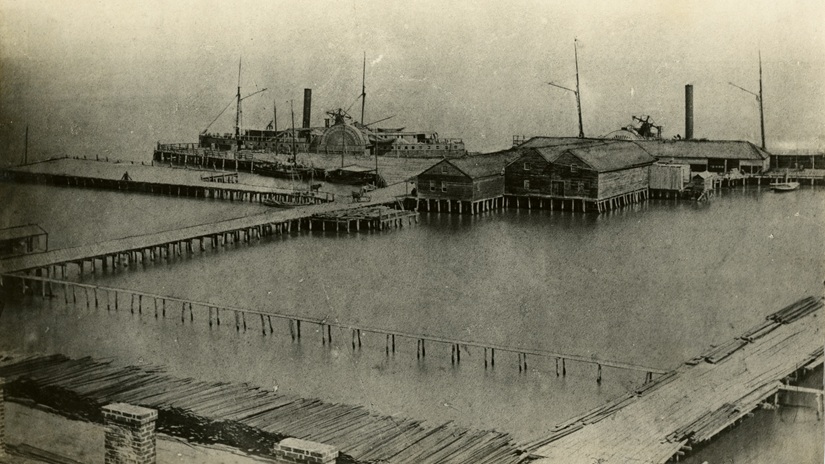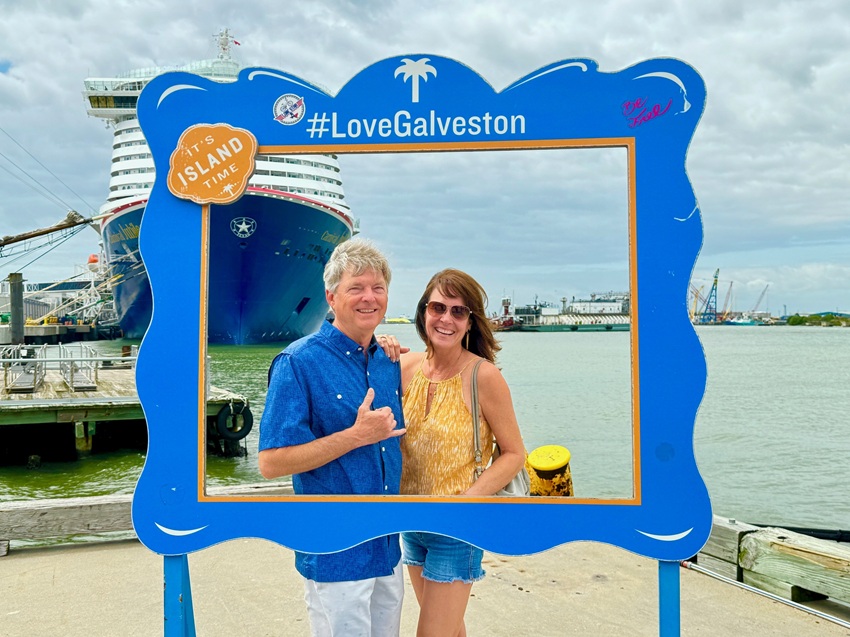Port of Galveston Celebrating 200 Years of Maritime Commerce
 An 1861 photo of the Port of Galveston showing Central Wharf, located at the foot of 21st Street, as seen from the top of the Hendley Building on the Strand. Photo courtesy of Rosenberg Library, Galveston, Texas.
An 1861 photo of the Port of Galveston showing Central Wharf, located at the foot of 21st Street, as seen from the top of the Hendley Building on the Strand. Photo courtesy of Rosenberg Library, Galveston, Texas.
Spanning two centuries, the Port of Galveston’s fascinating history could fill a book with tales of pirates, naval battles, riches, and resilience. The port is marking its remarkable 200th anniversary in 2025 with public events, publication of a history book and more.
“We’re planning a full year of activities to share the port’s history, spotlight contributions by the port and its port partners, and celebrate our past, present and future,” said Rodger Rees, Galveston Wharves port director and CEO.
A long, rich history
Galveston, or Galvez's town, was named after 18th-century Spanish military and political leader Bernardo de Gálvez, 1st Count of Gálvez (1746–1786), who was born in the Kingdom of Spain. The Port of Galveston is the oldest port in the Gulf of Mexico west of New Orleans. It was established by a proclamation issued by the Congress of Mexico on October 17, 1825, while the land known as Texas still belonged to Mexico.
The port played a vital commercial and military role in the Texas Republic’s battle for independence from Mexico. Its harbor was home to the Texas Navy, a squadron of four sailing vessels, which contributed to Sam Houston’s success over General Antonio Lopez de Santa Ana at the Battle of San Jacinto in 1836. As the natural harbor grew in prominence, the city of Galveston, founded in 1839, grew around the port.
In the 1850s, the port of Galveston exported approximately goods valued almost 20 times what was imported. The main export was cotton. The Galveston Wharf Company took control of the port in 1869 and built a grain elevator in 1875, leading Galveston to become a major grain exporter. By the 1870s, the Port of Galveston was a major U.S. commercial center with far-reaching maritime and rail connections. By 1878, the port of Galveston was the nation's 3rd largest cotton exporter and winning $6.2 million in federal funding in 1890 to become a deepwater port. In 1900, Galveston was ranked the fifth most important port in the country. Exports totaled more than 85 million dollars with the port ranking first place in the export of cotton and third in wheat exports.
Galveston's wealth was due in large part to the port's activity. The port continued to primarily export agricultural goods. Local leaders often blamed the lack of industrial goods to export on the city's lack of an adequate water supply. However, when the city water project finished in the early 1890s, industrialization still did not occur. Many companies were hesitant to invest in machinery on an island prone to floods. But Houston was able to better attract industry and began positioning themselves as a viable alternative to Galveston.
The port survived the Galveston Hurricane of 1900, but the railroad connecting the island to the mainland suffered significant damage In response to the hurricane, city leaders dredged the ship channel to raise the island's grade. Now the port was considered a deep-water port and was able to handle larger ships. By1914, Galveston "was the leading cotton port in the world, the third-largest exporter of wheat, and an important sugar import center." The port also became a major immigration center soliciting immigration to help recovery and rebuild, with almost 50,000 people entering the country between 1907 and 1914. The Intracoastal Canal opened in 1933.
 The Port of Galveston is ranked as the fourth busiest cruise port in the U.S. and a major U.S. cargo port. Photo courtesy of Galveston Wharves; Robert John Mihovil, photographer.
The Port of Galveston is ranked as the fourth busiest cruise port in the U.S. and a major U.S. cargo port. Photo courtesy of Galveston Wharves; Robert John Mihovil, photographer.
In the 1990s, port officials attempted to bring modern cruise ships to Galveston. In 2000, the Carnival Cruise Lines ship Celebration debarked from the port of Galveston. Other ships based in Galveston in the first years, were small and older. In 2006, the port invested more than $85 million to build and improve facilities to bring more ships in.
Port cargo
The port is equipped to handle all types of cargo including containers, dry and liquid bulk, breakbulk, RO/RO, refrigerated, and project cargoes. The Galveston Railroad, a terminal switching railroad, facilitates movement of cargo by rail. In April 2016, a BMW vehicle distribution center was opened at the port. This was the result of a public-private partnership that the port entered into with Wallenius Wilhelmsen Logistics Vehicle Services Americas
Since then, key milestones have included the federal harbor deepening from 36 feet to 40 feet in 1976, longtime tenant Wallenius Lines moving its cargo operations to the port in 1995, and arrival of the Carnival Celebration, the first cruise ship to homeport here, in 2000.
Today, the 840-acre port is a thriving commercial center with infrastructure and assets to serve growing cruise, cargo and commercial businesses. The port is the fourth most popular cruise home port in the U.S. and hosting five major cruise lines. More than 3.4 million cruise passengers moved through the port’s three terminals in 2024.
The port also leases and maintains a wide range of cargo facilities on the deep-water Galveston Harbor, which is ranked among the top 40 busiest U.S. cargo waterways.
200th anniversary events
 Events planned for the 200th anniversary later in the year for the community are:
Events planned for the 200th anniversary later in the year for the community are:
- Party on the Pier. Slated for Oct. 17, this event will be presented by Royal Caribbean with a spectacular drone show, live music, a Jean Lafitte lookalike contest, food trucks, and family fun. Mexico designated Galveston a provisional port of entry on Oct. 17, 1825, while under Mexican rule.
- Bicentennial Gala. Carnival Cruise Line will present an elegant evening of dinner and dancing at the Port of Galveston's 200th Anniversary Gala at the Galveston Island Convention Center.
- Port history book to be published in October.
For more information about future Port of Galveston events, visit www.portofgalveston200.com.
